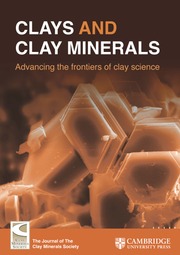Article contents
Influence of mineral composition and firing temperature on the micro- and mesoporosity of replicate archaeological ceramics
Published online by Cambridge University Press: 25 September 2024
Abstract
The role of micro- and mesopores of archaeological ceramics in preserving ancient biomolecules is not well established. To understand the formation of these nano-sized pores in ceramics, reference pottery briquettes were made using two different clay types (illitic and kaolinitic clays), two different tempers (sand and chalk), and two different firing temperatures (600 and 800°C). The mineral content of the briquettes was determined by quantitative X-ray diffraction, and the micro- and mesopores were characterized with the N2 adsorption method. The Brunauer–Emmett–Teller method, the adsorbed volume near liquefaction, and application of non-local density functional theory (NLDFT) were used on the N2 adsorption data to determine specific surface areas, specific pore volumes, and pore-size distributions. Values of the micro- and mesoporosity parameters of most of the briquettes were approximately proportional to the initial clay content and unrelated to temper; the proportionality factors were much larger for illitic clay than for kaolinitic clay. When chalk-tempered briquettes were fired at the higher firing temperature of 800°C, the parameters were no longer proportional to the initial clay content; they decreased in most briquettes formed of illitic clay due to reaction of the clay with lime, and they increased in briquettes formed of kaolinitic clay due mostly to the porosity of unreacted lime. Micropore volumes in briquettes formed mostly of illitic clay were substantial: of the order of 5 mm3 g−1. The work presented here forms a basis for future studies to establish a plausible mechanism of organic residue absorption and preservation in ancient ceramics.
Information
- Type
- Original Paper
- Information
- Copyright
- © The Author(s), 2024. Published by Cambridge University Press on behalf of The Clay Minerals Society
References
- 4
- Cited by


